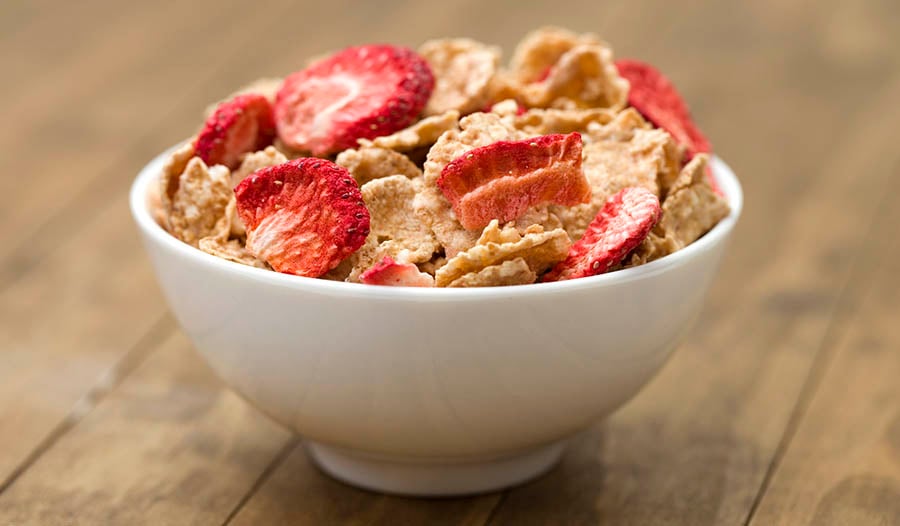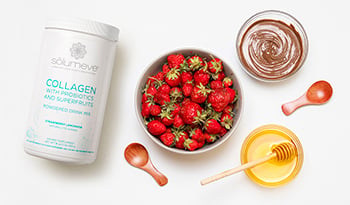Freeze-Dried Strawberries and Cardiovascular Health
DISCLAIMER:This blog does not intend to provide diagnosis...
- In this article:
- Data:">Background Data:
- Commentary:

The consumption of flavonoid sources such as strawberries, blueberries, apples, dark chocolate, and red wine have all been shown in population studies to be associated with a significantly reduced risk for heart attacks and strokes. For example, data from the Nurses’ Health Study (NHS) II of 93,600 women showed that a combined intake of >3 servings a week of blueberries and strawberries was associated with a 34% decreased the risk of having a heart attack compared to those consuming the berries once a month or less.
A study shows that even eating freeze-dried strawberries produces valuable effects in reducing heart disease risk.
Data:">Background Data:
The major benefits of consuming strawberries and other flavonoid sources in protecting against cardiovascular disease (CVD) is largely due to their effects on improving the function of the cells that line the blood vessels (endothelial cells). The endothelial cells play a pivotal role in the regulation of vascular tone and structure as well as vascular inflammation and clot formation. The lesions of atherosclerosis (hardening of the arteries) first begin to develop with damage to endothelial cells. Flavonoids, particularly the proanthocyanidin types found in berries, and also those found in other flavonoid-rich foods have all been shown to protect and improve endothelial cell function.
A study was reviewed that sought to evaluate the effect of strawberry consumption on cardiovascular disease risk. Healthy volunteers were supplemented daily with 500 g of strawberries (about 2½ cups) for 1 month. Strawberry consumption significantly reduced total cholesterol, low-density lipoprotein (LDL) cholesterol, and triglycerides levels (-8.78%, -13.72% and -20.80%, respectively) compared with the baseline period. Strawberry supplementation also significantly decreased various markers of oxidative stress. A significant increase (>40%) in plasma total antioxidant capacity was also observed after strawberry consumption. In addition, strawberry consumption also improved platelet function, which is a key factor in preventing the formation of blood clots that can break off and cause a heart attack, stroke, or pulmonary embolism.
Data:
A study was designed to determine if freeze-dried strawberries (FDS) improve levels of blood lipids (cholesterol and triglycerides) and lower biomarkers of inflammation and lipid oxidation in adults with abdominal obesity and elevated serum lipids.
The 60 volunteers were assigned to consume 1 of the following 4 beverages for 12 weeks: 1) low-dose FDS (LD-FDS; 25 g/d); 2) low-dose control (LD-C); 3) high-dose FDS (HD-FDS; 50 g/d); and 4) high-dose control (HD-C). Control beverages were matched for calories, total fiber, appearance, and taste.
Results indicated a dose-response to FDS as the high-dose group experienced significantly greater decreases in serum total and LDL cholesterol compared to the lower dosage.
Both doses of strawberries showed a similar decrease in a marker of cellular oxidative damage (serum malondialdehyde) at 12 weeks. In general, strawberry intervention did not affect blood pressure, blood sugar, and serum concentrations of HDL cholesterol and triglycerides, and C-reactive protein (a marker of inflammation).
Commentary:
I found this study extremely interesting. Previously, I had reviewed a study that showed dietary fiber from fruit intake offered the greatest impact on reducing CVD mortality. Higher fruit fiber intake reduced CVD mortality by 32%. This current study suggests that the benefit might be a combination of effects including the lowering of cholesterol due to the fiber components.
Fresh fruit is obviously the best choice, but the point that this study drives home is that even ingesting a very mild intake of dried strawberries produces a clinically meaningful reduction in CVD.
Reference:
- Basu A, Betts NM, Nguyen A, et al. Freeze-dried strawberries lower serum cholesterol and lipid peroxidation in adults with abdominal adiposity and elevated serum lipids. J Nutr. 2014 Jun;144(6):830-7.

 By Dr. Michael Murray, N.D.
By Dr. Michael Murray, N.D. 


